Want to start a Travel Blog but don’t know where to begin? This insanely actionable travel blogging for beginners guide walks you through exactly how to start a travel blog that can make you money and keep you travelling for longer.
I think you’ll agree with me when I say:
Starting a travel blog can be REALLY confusing. There is so much conflicting information out there that it’s difficult to know which advice to follow.
But it doesn’t have to be!
As it turns out, you can easily set up your travel blog, design your website and write your first post a lot quicker than you ever thought possible.
And in today’s post, I’m going to walk you through exactly how to start a travel blog with WordPress that can make you money and keep you travelling for longer.
Let’s get started!
How To Start A Travel Blog In 2019
- Pick A Unique Travel Blog Name
- Set Up A Hosting Account
- Install WordPress (For Free)
- Install A Theme And Design Your Blog
- Create Your Main Pages
- Install Useful Plugins
- Write Your First Post
- Set Up Your Social Media Accounts
- Find The Perfect Email Marketing Software
- Monetise Your Blog
- Sign Up To A Travel Blogging Course
1. Pick A Unique Travel Blog Name
The first step when starting a travel blog is choosing a unique domain name (the name of your website).
Too many people spend weeks and weeks trying to come up with the perfect blog name (I’m guilty of this) and never end up starting their blog.
Luckily there are a few things you can do (and avoid) so that choosing a domain name is easy.
Make it Short and Sweet
You want to have a name that’s easy to remember and that explains what your blog is all about.
For example, ‘Travelling-The-World-For-1-Year.com’ is a bad travel blog example because it’s too long, includes a number (which you then have to explain whether it’s a ‘one‘ or ‘1‘) and uses hyphens.
You want to try to avoid using hyphens and numbers because each time you tell someone about your blog, you’re going to need to explain how to type the URL.
“Hey, check out my travel blog, it’s Travelling (2 l’s) hyphen The hyphen World hyphen For hyphen 1 (the number) hyphen Year dot com.”
Do you see the problem with this?
Avoid Pigeonholing Yourself
If you use a name such as ‘SouthAmericanTourist.com’ or ‘MyYearAbroad.com’, you’re going to run into problems.
What happens if you want to travel longer or to different locations?
It’s time-consuming and difficult to change blog names, so make sure you don’t pigeonhole yourself to a specific location or certain timeframe.
Avoid Overused Words
Nomadic, Traveller, Vagabond, Wandering, Adventurous etc. are all words that have been used to death. More established blogs already use these words so you’ll find it more difficult to stand out from the crowd.
Try to be more creative.
Pick a Name that Describes Your Niche
You want people to see the name of your blog and know exactly what your website is about. My blog is all about living abroad and travelling long-term so “Move Your Life Abroad” was an easy pick for me.
The best way to think of a great travel blog name is listing words that describe your blog.
What do you want to write about?
What type of travel do you enjoy?
What’s unique about the way you travel?
Write down a list of words that best describe the type of travel you enjoy and use a thesaurus to find unique words that are less commonly used but still sound great.
After you’ve listed a few words that you like the sound of, visit Bust A Name and type in the words into the left column. This fantastic tool will mix the words together and give you a list of available domain names.
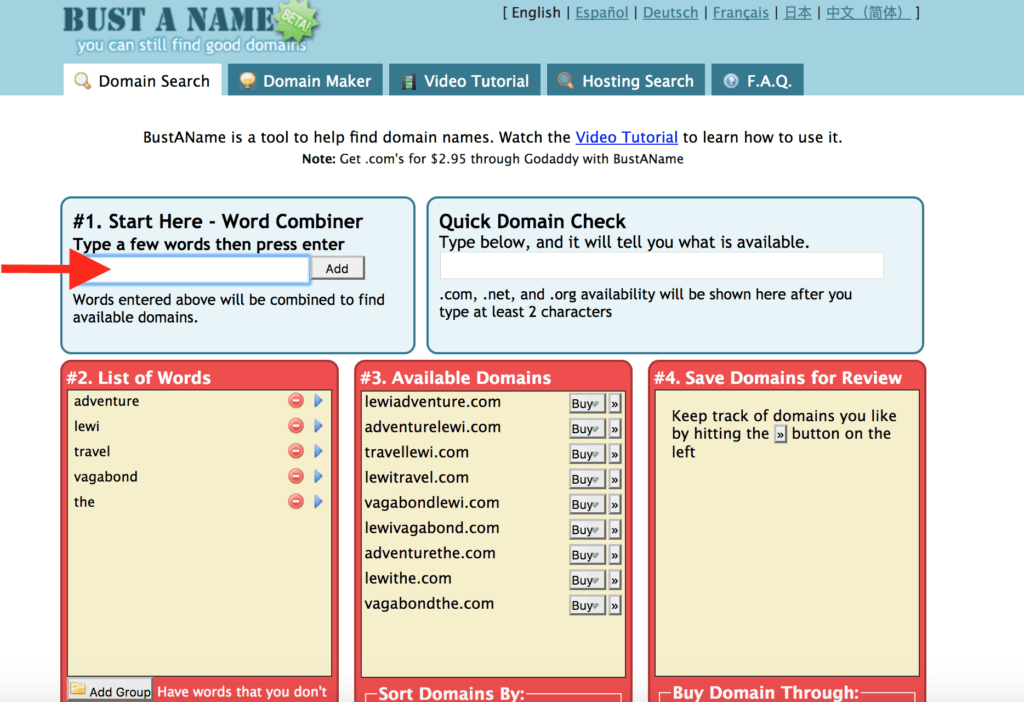
Obviously, you should come up with more creative words than I have in the above image. This is just an example to show you how the tool works.
2. Set Up A Hosting Account
After you’ve decided on a name, you need to set up your hosting account and buy your domain name.
Many people get confused about what hosting actually is. Simply, you need to have somewhere on the internet to store all of the data from your blog including your photos, articles, media etc. and that’s what hosting companies are for.
You need to make sure you choose a reputable hosting company because if something goes wrong, you want support to be able to help you.
The best place to buy your domain name and set up a hosting account is with BlueHost.
BlueHost is simply the best place for beginners to start out because they are reliable and their support is second to none.
You can get a huge discount on your hosting and a free domain name by clicking the button below.

Type in the domain name that you’ve chosen in Bust A Name and purchase your hosting plan with BlueHost.
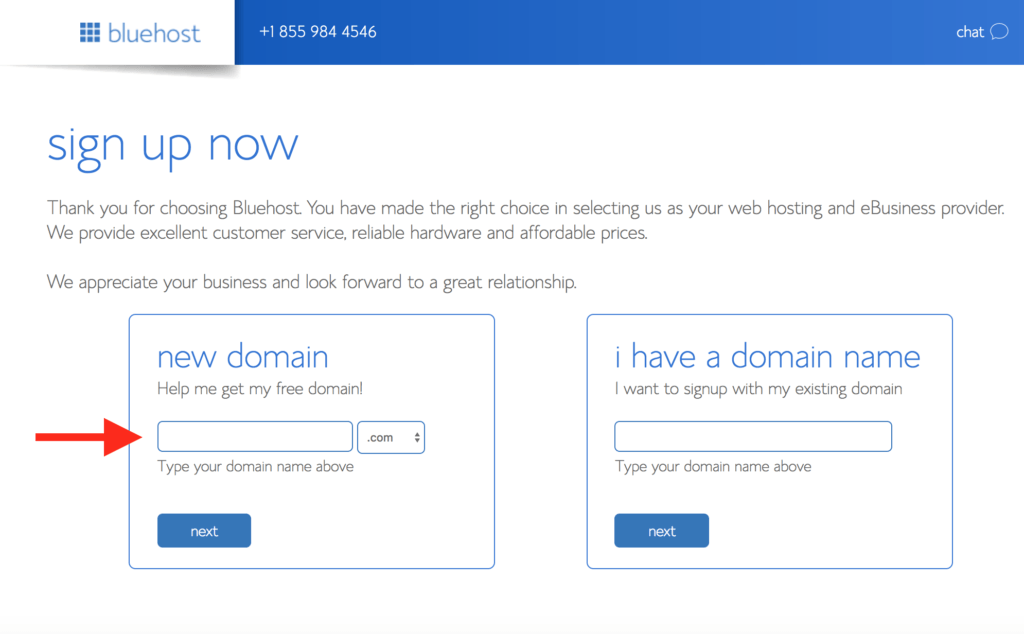
3. Install WordPress (For Free)
After logging in and setting up your payment details you’ll be prompted to do the BlueHost onboarding process.
I recommend that you do the on boarding process as it will set up your hosting account, install WordPress and upload important plugins to your website.
Basically within a few minutes you’ll have your website ready to edit.

After the on-boarding process, you’ll end up in the WordPress dashboard. This is the backend of your website and where you’ll control the settings for your whole website.

What is WordPress?
“WordPress is a publishing platform that makes it easy for anyone to publish online, and proudly powers millions of websites. It comes in two flavours: the fully hosted WordPress.com, and the self-hosted version, whose software is available for free at WordPress.org.” – WordPress
Wait, there is WordPress.com and WordPress.org?
What’s the difference?
Essentially no matter what, you’re going to need to use WordPress.org to run your website. WordPress.org is the software that actually runs your website (no matter if you are self-hosted (Blue Host) or fully hosted by WordPress.com.
However, if you want to host your website for free using WordPress.com instead of another hosting company such as Blue Host, you can do that as well.
The problem is that the free hosting from WordPress.com makes your domain name look like this:
‘”ww.YourBlogName.Wordpress.com” instead of a much cleaner “www.YourBlogName.com”
Can you see how much more professional the second name looks?
Would you take a website seriously if its URL was ‘www.NameOfWebsite.Wordpress.com‘?
Probably not!
Advantages of a Self-Hosted (Blue Host) Website:
-Unique URL (‘”ww.YourBlogName.com” rather than “www.YourBlogName.Wordpress.com”‘)
-Looks more professional
-Optimised for SEO (search engine optimisation) so you’ll be ranked in Google search
-Control over how you use and store your data
-Professional themes (design of your blog)
-Monetization possibilities in the future
-Google Analytics to track the performance of your website
If your blog is just going to be a hobby to share your adventures with friends and family, then using WordPress.com is fine. However, if you want to take your blog seriously and make money from it, you’re going to need to self-host your website using a hosting company (Blue Host).
Try to use the analogy that running a website is like running a car.
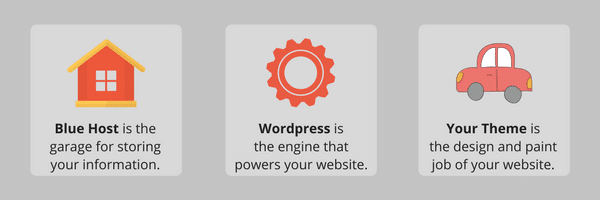
Using WordPress can be overwhelming at the start, so if you need any help, I recommend signing up to my FREE in-depth course “How To Start A Travel Blog.”
4. Install A Theme And Design Your Website
By now, you should have bought a unique domain name, set up your hosting account with BlueHost and installed WordPress.
This is where the fun begins!
It’s time to install a theme and design your blog.
After installing WordPress you’ll be logged into the WordPress dashboard. This is where you control your whole website!
For future reference, in order to log in to WordPress, you can enter the following URL:
“YourBlogName.com/wp-login“
From the WordPress dashboard, navigate your way to the ‘Appearance‘ tab in the sidebar and click ‘Themes‘.
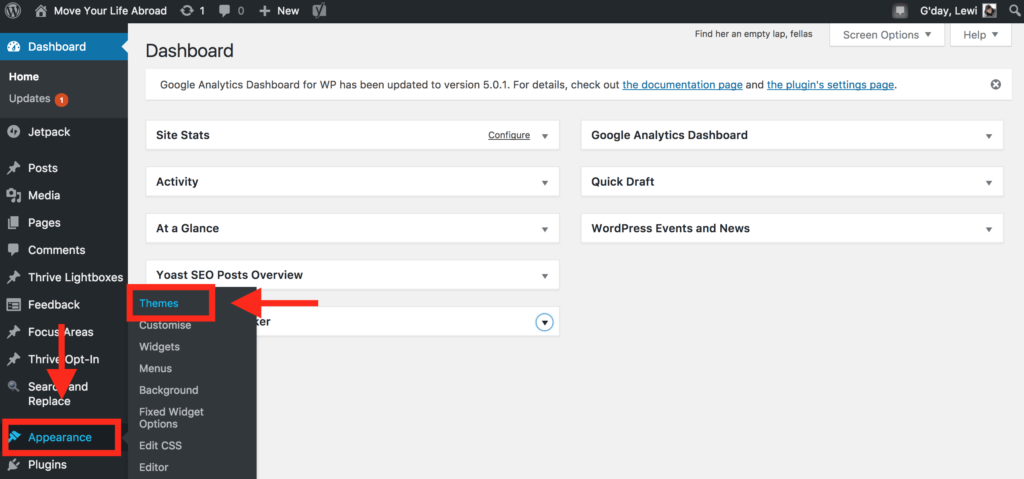
A theme is the design of your website. Rather than having to learn how to code or pay someone to design your website, you can install a theme and optimise it yourself.
While there are many free themes out there, if you’re going to take your blog seriously (and plan on blogging for a while), I recommend buying a premium theme ($20-$80 USD).
Unfortunately, the free themes lack support, customization and aren’t optimised for SEO (which drives traffic to your website).
If you prefer to pay a designer to set up a professional looking blog, you can find them on UpWork or 99 Designs. This is going to cost you anywhere between $1,500-$5,000 USD.
Purchasing a premium theme and optimising it yourself will not only save you money but teach you how to run your website and customise it however you like.
Whereas if you pay a designer, every time you want to change something (which will be more often than you think), you’re going to need to contact your designer and pay them again.
Some great places to buy premium themes include Studio Press, Theme Forest and Elegant Themes.
Honestly, there is only one theme that I use for all of the websites that I create. That is the Astra Theme.
It allows for so much customisability and you can import starter sites. These starter sites are already pre-built websites that allow you to import beautifully designed websites that you just have to customise with your information.
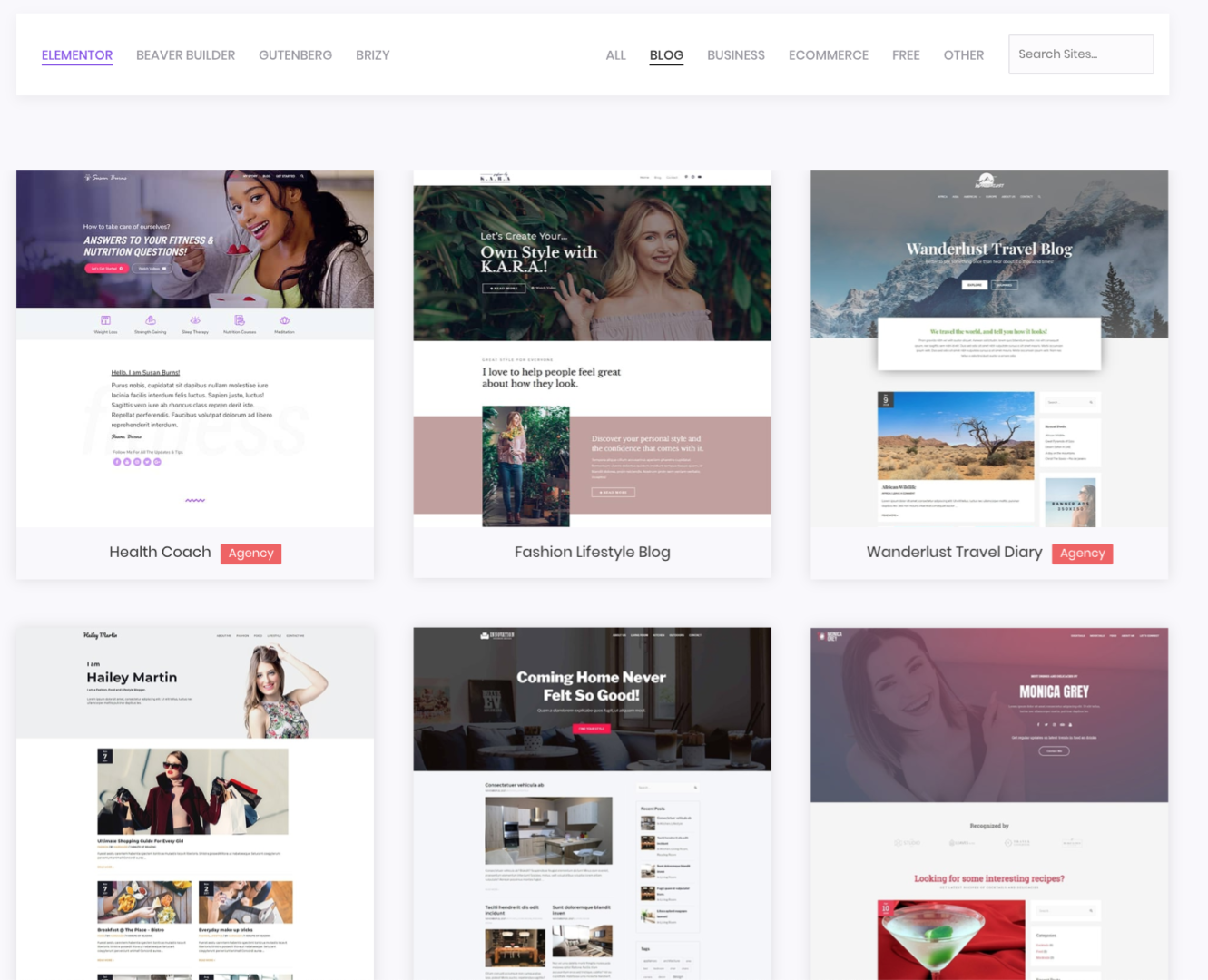
The best part about the astra theme is it is completely free to get started.
They do have a paid pro version, but when you get started you don’t need that.
After downloading your theme, you’re going to need to upload the zip file to WordPress.
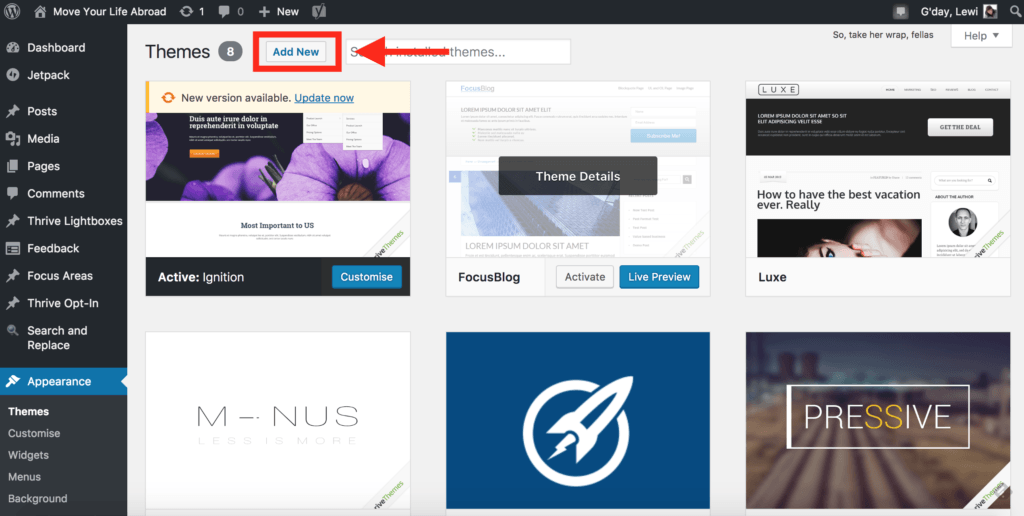

5. Create Your Main Pages
The great thing about installing a starter site with Astra is that all of the pages are already created and designed for you. All you need to do is tweak the design to your liking and add information to the pages.
When starting out, I recommend having the following pages:
–Home
–About
–Blog
–Contact
–Disclaimer
–Privacy
The way that you’re able to customise the look of your website is through a page builder called Elementor.
It is a free plugin that allows you to edit the look of your website using a drag and drop editor.
If you want more advice on Web Design and how you can make money selling websites in WordPress, check out my FREE Web Design course.
6. Install Useful Plugins
“Plugins are ways to extend and add to the functionality that already exists in WordPress…plugins then offer custom functions and features so that each user can tailor their site to their specific needs.” -Wordpress.org
To add plugins, click the ‘Plugins‘ button on the sidebar and ‘Add New‘.
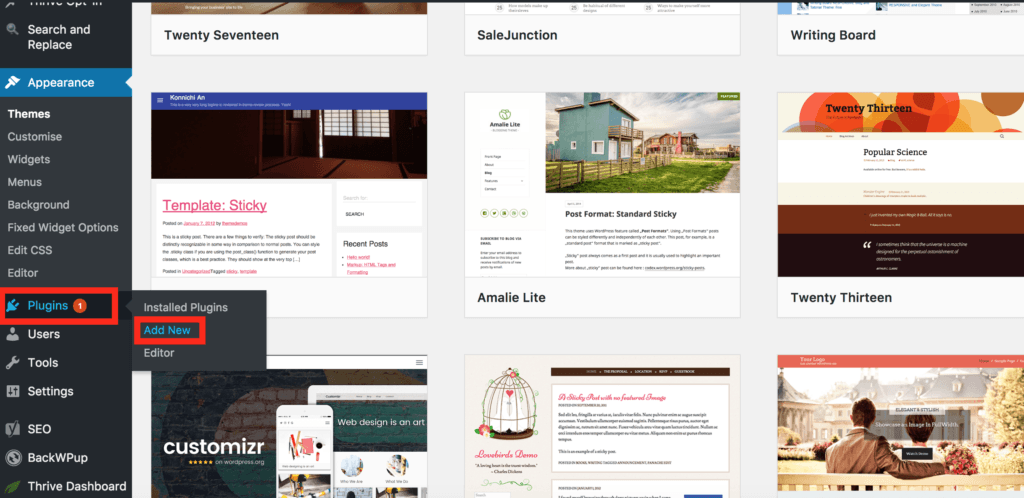
Plugins I Recommend Starting With:
–Yoast SEO (Free)
This plugin is very important because it will help you rank in Google search and drive more traffic to your website.
–Akismet (Free)
Unfortunately, most websites receive spammer comments on their blog posts. This plugin helps automatically filter spammer comments so they don’t appear on your site.
–Thrive Leads ($67)
People who sign up to your email list are engaged readers who are more likely to buy from you in the future. This is one of the best plugins out there for capturing email signups and has many different designs and split-testing features.
–WPtouch Mobile Plugin (Free)
More than half of traffic driven to top websites is from mobile devices. With this plugin, your website will be mobile friendly meaning a better user experience for mobile users.
–BackWPup (Free)
After spending so much time working on your website, you’d be crazy not to back it up. This plugin allows you to automatically schedule regular backups to Dropbox and other cloud storage services, so you can set it and forget it.
–Google Analytics For WordPress (Free)
When you first launch your website you won’t be receiving much traffic. However, after a little while, your traffic will start to increase and this plugin will give you important information about your reader demographics and traffic sources.
–W3 Total Cache (Free)
This plugin saves copies of the pages from your website, meaning WordPress doesn’t have to generate new ones for each reader. Essentially this means that your website will load much faster and keep readers coming back to your website.
–Contact Form 7 (Free)
This plugin is perfect for adding a contact form to the ‘Contact Page‘ of your website, making it easier for people to get in touch with you.
7. Write Your First Post
By now you should have designed your website and created all of the pages that I suggested above.
It’s finally time to write your first blog post!
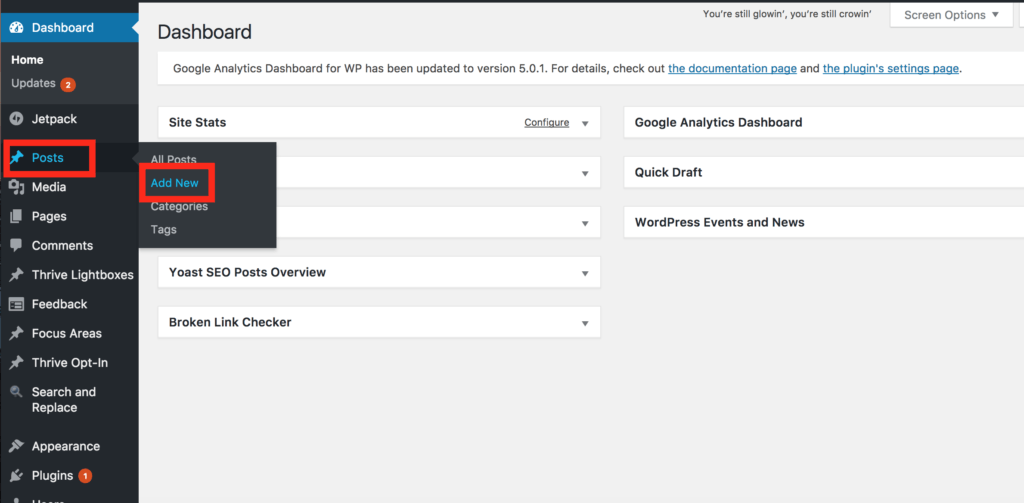
What Should You Write About?
There’s a lot of information out there on how to write a travel blog post but for your first post, you should talk about what made you start the blog, your travel experience and goals for the future.
Essentially, you want your first post to be an extended and more in-depth version of your about page.
If you don’t have much experience writing, you’re probably going to find it difficult to write your first travel blog post (I know I did).
Don’t worry!
Pretend like you’re writing an email to a friend and don’t spend too long trying to perfect your first post. The more you write, the better you’ll become.
If you’re really looking to kick-start your travel writing with a bang, I suggest taking Nomadic Matt’s Travel Writing Course.
Article Ideas
Beyond your first blog post, there are many topics that you can write about. Destinations, Travel tips, travel stories, crazy adventures, food recommendations etc.
If you aren’t travelling at the moment, write about previous trips you’ve taken, things to do in your local city or what you plan on packing for your next overseas trip.
If you still can’t come up with any content ideas, read this article.
The trick is to write engaging content that will keep readers coming back. You want your audience to take something positive away every time they visit your website and read your posts.
So take time and care producing the most compelling content you can.
8. Set Up Your Social Media Accounts
Posting on social media and creating a brand is going to be extremely important for acquiring traffic to your blog. Learning how to promote yourself on social media is part of learning how to start a travel blog.
Even if you don’t plan on diving into social media straight away, it’s a good idea to reserve the same social media handle across all platforms (I didn’t do this and my social media following is lacking because of it).
For example, if your blog is called “AdventuresOfYourName.com” you want all of your social media handles to be “AdventuresOfYourName“.
This will make it less confusing for people when searching for you on the different social media platforms.
You should set up your social media accounts on the following platforms:
–Facebook
–Twitter
–Pinterest
–Instagram
–YouTube
Once you’ve registered the social media handle across all platforms, stick to 1-3 platforms to focus your attention on.
In the beginning, you’re not going to have enough time to post regularly and grow your following on all these networks.
9. Find The Perfect Email Marketing Software
Most people think that Email Marketing is an advanced marketing strategy that should be ignored when learning how to start a travel blog.
This couldn’t be further from the truth!
Creating an email list on your blog is one of the most important first steps.
Why is This so Important?
The people that sign up to your email list are usually engaged readers and loyal fans. With email being a more personal and intimate form of contact, your email subscribers will be more willing to share your blog posts and potentially buy products from you in the future.
How to get Email Subscribers?
The easiest way to get people to sign up to your email list is by offering an incentive, otherwise known as a lead magnet. This is a piece of valuable content that is sent exclusively to people who sign up to your list.
Examples of Lead Magnets That I use:
–How Anyone Can Earn Money Abroad In 48 Hours!
–Find The Perfect Accommodation Abroad
–List of More Than 100 (High Paying) Websites That Pay Writers
-FREE Affiliate Marketing Course
I’m able to create these landing pages and catch people’s email addresses through an opt-in software called Thrive Leads (which I mentioned earlier).
There are many different email marketing companies out there and it can be confusing to know where to start.
Mailchimp is the most popular email marketing company for beginners because it’s free (for your first 2,000 subscribers) and easy to use.
Unfortunately, with Mailchimp and other basic email marketing software you’re very limited in what you can do.
I use Active Campaign for sending all my emails and I LOVE IT!
Active Campaign allows you to set up email marketing automation which enables you to send personalised messages to your email subscribers.
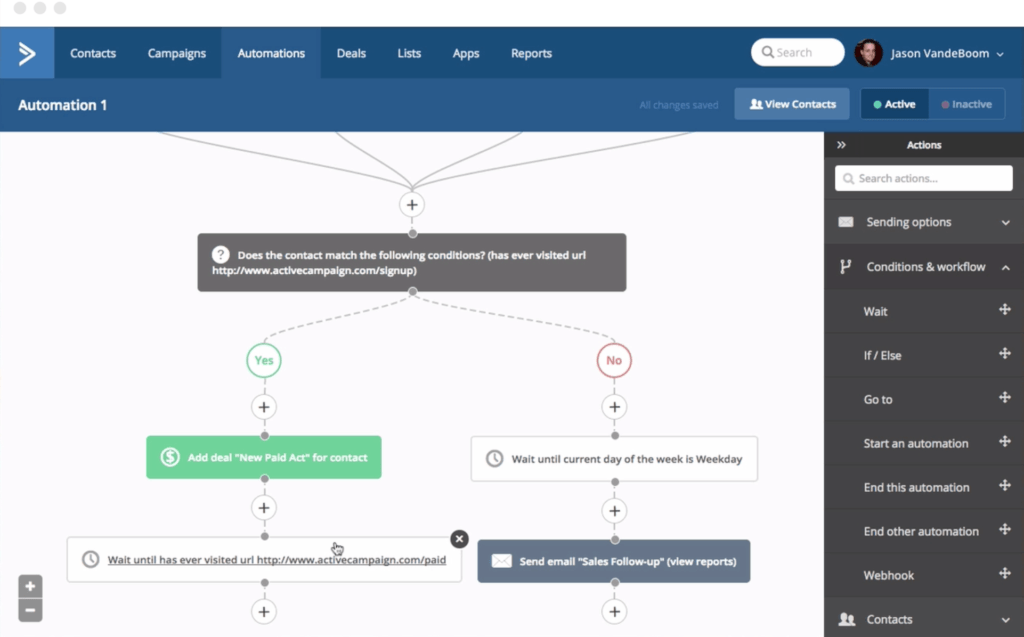
How Can You Use This?
Well, if for example, you create a 5-day email series on “How To Move Your Life Abroad In 30 Days” as a lead magnet, you would be able to create a custom automation that sends those 5 emails over the course of 5 days, rather than having to send each email individually.
Here is a screenshot of a very simple automation that I created for my free email course, How To Move Your Life Abroad In 30 Days:
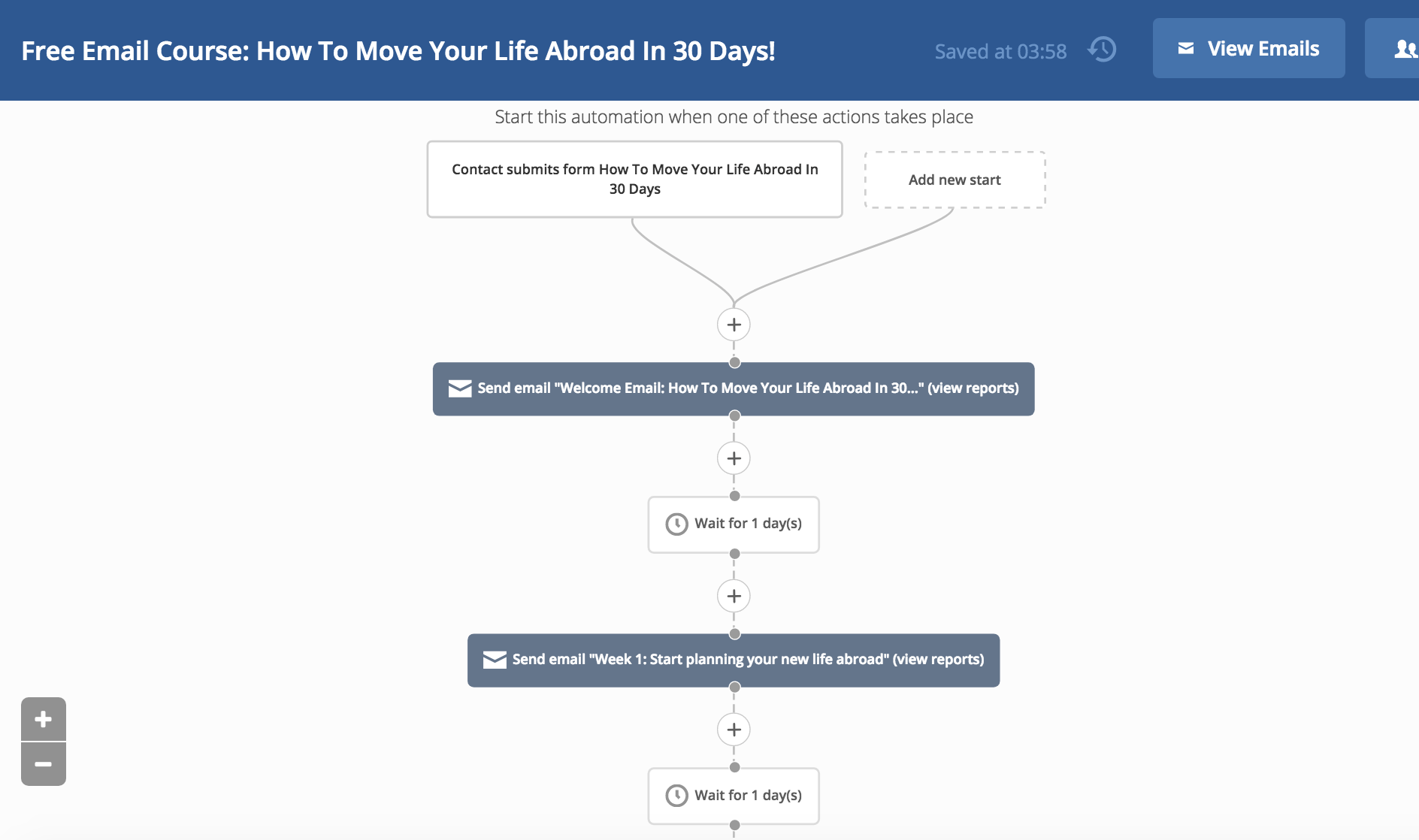
You can see that I’m able to tell Active Campaign to wait 1 day before sending each email so that I don’t have to manually email each email subscriber every day.
For more information and video tutorials on the Automation possibilities of Active Campaign, check out my FREE course on Email Marketing Automation.
10. Monetise Your Blog
Most people want to learn how to start a travel blog for the sole reason of making money from it.
Unfortunately, travel blogging is extremely competitive and it normally takes anywhere between 1-2 years before you’re making enough money from it to be travelling full-time.
However, if you’re a motivated and passionate blogger you can definitely make it work and earn an income from a travel blog.
In the meantime, a great way to earn money online while you’re travelling is by writing articles online.
Different Ways To Monetise Your Blog:
Affiliate Marketing
You may have seen those advertisements online that say “Learn how to make money while you sleep“. That is what the idea of affiliate marketing is all about.
You sign up to affiliate programs such as ClickBank, Commission Junction and Awin, insert affiliate links onto your website, get your readers to click those links and let the money start rolling in.
Pretty easy right?
Wrong.
As you may have guessed by now, it isn’t as easy as just putting up an affiliate link onto your website and watching the money roll in. You need to have a large audience that reads your blog in order to get enough people to click on the links and buy the products you’re promoting.
Until you have a large readership, don’t expect to make a huge amount of money from affiliate marketing.
You should only promote products that you truly believe in because if you promote bad products, your readers won’t trust you anymore and won’t come back to your blog.
I have a FREE course on affiliate marketing and monetising your blog.
Sponsored Posts
Sometimes companies will ask you to do a review on one of their products and in return, they’ll pay you.
At the end of sponsored posts bloggers say something like this:
“This is a sponsored post meaning I was paid to write this article. All opinions are my own.”
Really, or are you just saying that so you get paid?
I really dislike bloggers who write too many sponsored posts (especially new bloggers) for products they’ve never even used. They say that “all opinions are my own” to try and keep the integrity of their blog but for the most part, they just say this so they don’t lose trust from their readers.
Be careful when accepting sponsored posts, especially in the beginning (I don’t recommend accepting any) because it’s one of the quickest ways to lose readers and kill your blog.
Advertisements
Putting up different types of advertisements on your blog is another way to make money from your blog.
There are two main types of advertisements that you can promote on your website.
You can advertise companies that you truly believe in and want to create a long-term relationship with or use Google Adsense (by inserting some code into your site).
The problem with Google Adsense is that the ads you display are randomly generated, which means that you could be advertising anything (including ads that aren’t relevant to your readers).
If you want to place advertisements on your website, I recommend reaching out to companies whose products you love and displaying their ads rather than using Google Adsense.
Creating Digital Products
The best and most honest way to make money from your blog is by creating a digital product such as Ebooks or online courses.
By creating your own product and promoting it to your readers you’re able to keep the integrity of your blog, provide a useful product and keep 100% of the profits.
What type of digital product should you create?
Well, that depends on what your niche is and what your audience is interested in.
For example, if your most popular blog posts are all about travelling long-term, you might consider writing an in-depth Ebook showing others how to achieve this.
A great way to gauge interest about a certain idea is by creating a relevant magnet.
Based on the number of email sign-ups to this lead magnet, you’ll be able to tell if people are interested in learning more about a certain topic.
Furthermore, you can email the people that signed up to your lead magnet and ask them if they would be interested in learning more. From their responses, you can get some great ideas of topics to include in your digital product.
11. Sign Up To A Travel Blogging Course
If you really want to take your travel blog seriously, then it’s definitely worth signing up for a travel blogging course.
The best course out there at the moment is Nomadic Matt’s Superstar Blogging Course.
NomadicMatt has been the number 1 personal travel blog for the last few years for one reason…
…his content is awesome, and his Blogging Course in no exception!
The In-Depth Course Covers:
– How to start a travel blog (you should have already done that by now)
– How to create a good looking website
– Basics of writing and editing blog posts (that go viral)
– How to network with other bloggers
– How to Succeed on Social Media
– How to get featured on larger blogs
– Optimising your website for SEO (Search Engine Optimisation)
– Email Marketing and Newsletters
– Monetizing your blog
…and much more!
I also have a FREE Travel Blogging course which teaches you more in-depth how to start your travel blog.
If you’re interested, you can learn more by clicking the button below.
Conclusion
I hope this travel blogging for beginners guide helped you realise that starting a travel blog doesn’t have to be difficult.
While you most likely won’t be making money a lot of money from your blog for a little while, those who focus their energy on telling good stories and providing value will win in the long run.
If you follow the steps above on how to start a travel blog, you’ll be able to create an amazing blog that shares your unique travel adventures with the world.
Blogging is my favourite method for sharing my travel experiences and knowledge, and it has been extremely effective for me because I followed the tips above.
Don’t worry if you’re finding the whole process a little overwhelming. Start by taking the first step (choosing a domain name) and then work your way through the rest of the steps at your own pace.
Happy blogging! I can’t wait to hear about all of your crazy adventures!
Do you have any questions about how to start a travel blog?
Disclosure: Some of the links on this page are affiliate links meaning I may make a small commission if you decide to purchase an item using one of these links. This helps me continue to maintain this website. You can be assured that I don’t recommend any products that I don’t use personally and think will benefit the readers of this website.

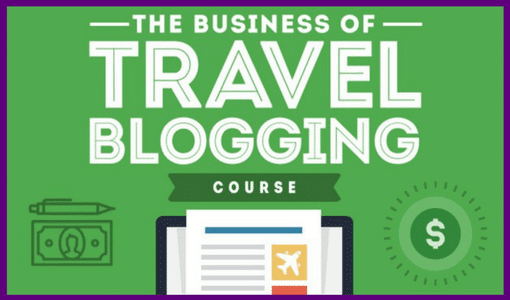
for ads its not google adwords but adsense
You’re right. Thanks for letting me know, I’ll change it now!
Thanks for these tips, really helpful! I already have a blog but I wish I would have read this before and would have signed up with wordpress 🙂
Hey Becky!
In the end if you’ve got a blog started with someone other than WordPress that’s alright. You can always change later (even if it may take a little time). The most important thing is to just keep writing and fine your style for now. I took a look at your blog, I like the design and feel of your site. who did you use instead of WordPress?Squarespace? Weebly?
Just a quick note the mobile functionality on some of your pages doesn’t work 100%. You might want to check that out.
Let me know if you have any questions 🙂
Very complete and useful guide! Excellent work. It helped me get started with a personal blog.
Im glad it was helpful to you Henry. All the best with your personal blog!
Pingback: 22 Easy Ways To Earn Money Abroad - LEWI BLAKE
I think that you will definitely succeed when starting your first travel blog. Just follow these tips. Wishing you all the best!